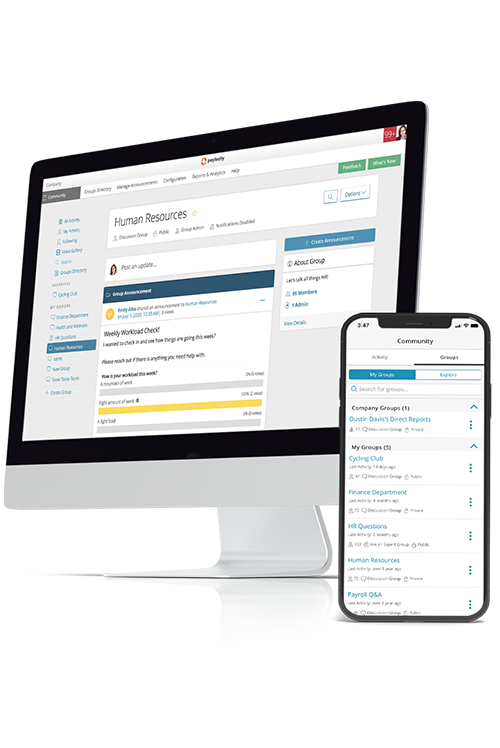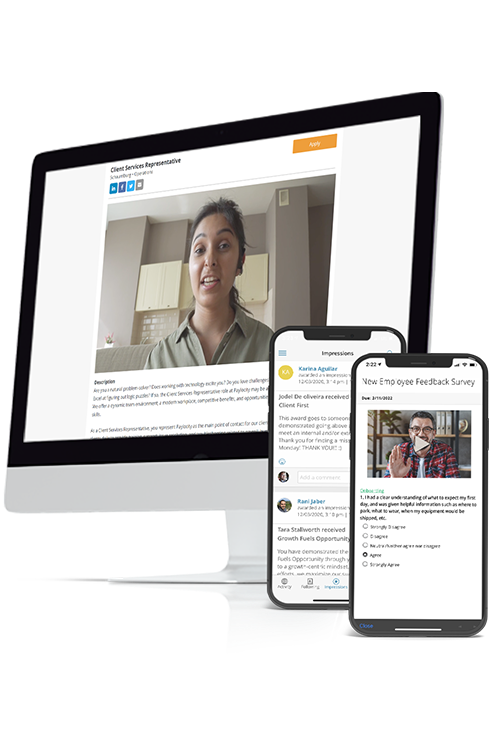
Leading Transformation: Change Management Tips for HR
Change isn’t just inevitable. It’s accelerating and multi-faceted.
We tell ourselves change is positive. But it can be both a growth opportunity and a disruption at the same time, which often causes considerable stress. Today’s rapid pace of change is one reason nearly half of workers in the U.S. and Canada experience stress daily. Let that sink in for a moment.
As HR professionals, we are in a unique position when it comes to organizational change management. While using data to drive decisions and ensure compliance with employment laws, we keep the focus on the human side of change.
Change theory tells us having strategies in place makes it easier to lead an organization through change. Let’s dig into effective change management practices and HR’s vital role as a facilitator of change.
Key Takeaways
- Change management is a systematic approach to helping employees adapt to new processes, policies, priorities, and technologies within an organization.
- HR plays a pivotal role in guiding employees through the change process, supporting alignment and engagement to successfully transition the organization.
- Consistent, transparent communication early on is essential for overcoming resistance and achieving successful change adoption.
What Is Change Management?
Change management is a systematic approach to helping people — your workforce — adapt to new processes, policies, priorities, and technologies.
There are different types of change, and leading through change means tailoring your strategy based on the specific circumstances your organization is facing. Types of change include:
- Strategic and organizational: changes to the business, including corporate goals, business structure, business policies, products and services, and markets.
- People, policy, and culture: changes related to people, such as restructuring, new leadership, updates to employee benefits or company policies.
- Structural and decision making: changes to the company’s hierarchy, including leadership, chain-of-command, communication flow, and operational procedures.
- Technology and systems: changes to the technology required to advance the company’s business and operations.
- External: changes coming from outside the company.
Whether or not you need a formal change management plan depends on how big an impact the change will have. The more people and systems impacted, the more you need a plan.
What Is HR’s Role in Change Management?
The success of any change effort starts and ends with people. When people are on board and aligned to the new direction change brings, the better chance you’ll collectively reach the desired destination.
Borrowing from the Kübler-Ross Change Curve, HR’s role in change management is to lead others past Denial and Resistance, through “The Valley of Despair,” and into Exploring and Commitment.
While an organizational change may not originate from HR, we are absolutely essential to its success. When HR is a strategic partner in navigating change, compared to when HR is not involved, organizations are 1.8x more likely to be highly effective at changing quickly at scale to capitalize on new opportunities.
Communicating Organizational Change
A breakdown in communication is one of the biggest potential pitfalls in the change management process. Crafting consistent messaging about the change and what it means to different stakeholders — including end users and frontline workers — is key to driving desired behavior changes.
When communicating about change to employees, tell the story from their point of view. How will it impact the way they work? What support and training will you provide throughout the change? Try relating the change to a familiar experience: “This is like switching from fax machines to email. It takes a little practice, but in the end, it’s so much faster.”
Honesty and transparency are critical. While outlining the benefits of a particular change, it’s okay to:
- Acknowledge the past.
- Acknowledge it’s hard.
- Acknowledge it takes time and reinforcement.
Throughout the change process, it’s also important to remember different people are at different stages of the Change Curve. Some stakeholders will have sat with a change for some time and are farther along in the journey, while others are just hearing about the change for the first time.
A Change Management Model and Framework
In a recent HR Mixtape podcast, I spoke with April Callis Birchmeier, owner of Springboard Consulting, speaker, and author. As we discussed the primary indicators of effective change management, April explained, “The only way we can get there as an organization is if the individuals in the organization make the decision to adopt that change.”
The ADKAR Model of Change Management
The goal of change management is for the organization to transition completely to a new way of doing things. At Paylocity, we follow the ADKAR model, which is based on the understanding that organizational change can only happen when individuals change. This methodology consists of five outcomes an individual needs to achieve for a change to be successful.
To put ADKAR into action at Paylocity, we use these best practices:
|
A |
Awareness |
Give employees plenty of advance notice, explain the “why” behind the change, and provide opportunities for employees to ask questions and make suggestions. |
|
D |
Desire |
Gauge employees’ reactions to the change, identify champions, and address individual concerns. |
|
K |
Knowledge |
Provide training or coaching to prepare employees for the change and address any skills gaps. Then, provide resources they can refer to later. |
|
A |
Ability |
Schedule practice runs when possible and monitor performance immediately following the change. Set reasonable goals, offer constructive feedback, and adjust processes as necessary. |
|
R |
Reinforcement |
Monitor the change over time to ensure it fulfills your desired outcome. Use positive feedback and recognition to encourage full adoption of the new process or tool. |
The READY, Set, Change! Framework
In her guide, READY, Set, Change! Simplify and Accelerate Organizational Change, April Callis Birchmeier outlines five steps to simplify and accelerate organizational change:
|
R |
Relevant and Relatable |
Build a relevant, relatable story about what the change actually is and what it means for employees. |
|
E |
Engage Leaders |
Use data and case studies to demonstrate to leadership the ROI of change management. |
|
A |
Advance Communication and Advocacy |
Make sure you lay the groundwork early with a carefully thought-out communications plan. |
|
D |
Develop Support |
Provide a variety of support structures and learning opportunities to help everyone transition through change. |
|
Y |
Reinforce WHY |
Reduce resistance to adoption by explaining the why of the change and reiterating the relatable story. |
In our podcast together, April points out that these steps happen both sequentially and simultaneously in an iterative cycle. Using the READY, Set, Change! framework can help you determine strategies that will lead employees to the desired outcomes described in the ADKAR model.
3 Strategies to Make Change Easier
Leading an organization through change may never be easy, but it can be easier. Here are three strategies to make transition and transformation go more smoothly.
1. Set Your Sponsor Up for Success
In change management, usually there’s a sponsor who is ultimately responsible for the change. Typically, the sponsor is an executive who actively advocates for the initiative throughout the change process. This person can make a big difference in galvanizing the organization to embrace the change and move forward.
Communication is key to effective sponsorship. Build on individual strengths to help your sponsor find the communication channels that work best for them, whether that’s in writing, in person, or on video — and possibly a combination of all three to reach all employees in your organization.
2. Make Change Fun with Gamification
Change can be a real drain on employee morale. One way to overcome resistance is to gamify the process. Engaging employees in fun but purposeful activities not only helps them learn but also gives them a sense of accomplishment.
How do you gamify change? By offering recognition and rewards as employees reach milestones. Hold a scavenger hunt for employees to find important information about the change. Create quizzes to help employees test their knowledge or work through a new process step by step. Recognizing the “winners” publicly with custom badges and announcements builds a cadre of champions for change. Giving out rewards — which can range from a prime parking spot to a monetary award — adds extra motivation.
3. Solicit Employee Feedback
When change happens, one of the first emotions we feel is a lack or loss of control. One of the most common mistakes in change management is not bringing your people along with you on the change. That’s why it’s so important to communicate early and often.
But communication must be a two-way street, especially during change. Employees need a forum to express their concerns and ask questions. As your initiative progresses, monitoring employee sentiment with surveys lets you track their comfort level with the change. Taking action when your data shows a bump in the road will go a long way towards making employees feel they have a voice in the change.
Insider Insights
It should come as no surprise to HR professionals that employee experience has a huge impact on change management success. When organizations are highly effective at designing a positive employee experience, they are also 2.5x more likely to be high performing at quickly changing to capitalize on new opportunities. Helping leadership understand the connection between engagement and agility, which is so critical in today’s world, will secure their buy-in for your change management plans.
How Technology Makes Transformation Simpler
Change doesn’t wait for us to make plans. So, how can we position our organizations for successful transformation before change happens?
Along with a change management strategy, having the right technology in place can help reduce disruption and speed up adoption. This is where an all-in-one HCM solution like Paylocity can really make HR’s job easier. With built-in employee experience tools including communication channels, a learning management system (LMS), employee feedback automation, and a customizable recognition platform, HR is well-equipped to maintain transparency and foster engagement throughout the change process.
Even though technology can sometimes be the source of change (hello, AI!), it’s also the linchpin to preventing change fatigue. If your organization is subject to ongoing change, you’ll want to leverage every tool at your disposal.



?$Hero-Card$)
